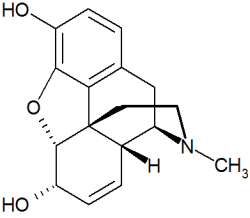Avinza
Morphine (INN), the principal active agent in opium, is a powerful opioid analgesic drug. Like other opiates, morphine acts directly on the central nervous system (CNS) to relieve pain, and at synapses of the arcuate nucleus, in particular. Side effects include impairment of mental performance, euphoria, drowsiness, lethargy, and blurred vision. It also decreases hunger, inhibits the cough reflex, and produces constipation. Morphine is usually highly addictive, and tolerance and physical and psychological dependence develop quickly. more...
Patients on morphine often report insomnia and nightmares.
The word derives from Morpheus, the god of dreams in Greek mythology.
Medical use
Administration
Morphine may be given parenterally as subcutaneous, intravenous, or epidural injections. The military sometimes issues morphine loaded in an autoinjector. Morphine can also be administered through a slow-release transdermal patch.
Orally, it comes as an elixir, concentrated solution, powder (for compounding) or in tablet form. Morphine is rarely supplied in suppository form. Due to its poor oral bioavailability, oral morphine is only one-sixth to one-third of the potency of parenteral morphine. Morphine is available in extended-release capsules for chronic administration, as well as immediate-release formulations.
Uses
Morphine is used legally:
- analgesic in hospital settings for
- Pain after surgery
- Pain associated with trauma
- In the relief of moderate to severe chronic pain
- Cancer pain
- Tooth extraction
- As an adjunct to general anesthesia
- In epidural anesthesia
- For palliative care (i.e. to alleviate pain without curing the underlying reason for it)
- As an antitussive for severe cough
- As an antidiarrheal in chronic conditions (e.g., for diarrhea associated with AIDS)
Contraindications
- Acute pancreatitis (this may be a result of morphine use as well)
- Renal failure (due to accumulation of the metabolite morphine-6-glucuronide)
Pharmacology
Morphine is an opioid agonist whose main effect is binding to the µ-receptors in the central nervous system. This is thought to be the reason behind the analgesia, euphoria, physical dependence and respiratory depression. Morphine also binds with k-receptors, which are thought to mediate spinal analgesia, miosis and sedation.
Legal classification
- In the United Kingdom, morphine is listed as a Class A drug under the Misuse of Drugs Act 1971.
- In the United States, morphine is classified as a Schedule II drug under the Controlled Substances Act.
- Internationally, morphine is a Schedule I drug under the Single Convention on Narcotic Drugs.
History
Morphine was first isolated in 1804 by the German pharmacist Friedrich Wilhelm Adam Sertürner, who named it "morphium" after Morpheus, the Greek god of dreams. But it was not until the development of the hypodermic needle (1853) that its use spread. It was used for pain relief, and as a "cure" for opium and alcohol addiction. Its extensive use during the American Civil War resulted in over 400,000 sufferers from the "soldier's disease" (addiction), though some believe this to be erroneous .
Read more at Wikipedia.org



